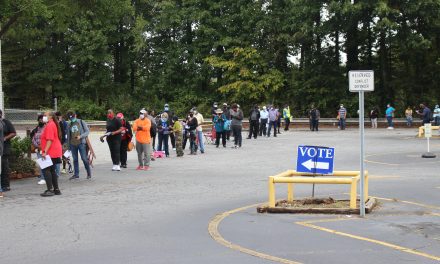In Emory’s Atwood Chemistry Center, Associate Professor of Chemistry Khalid Salaita and his lab are developing cutting-edge technology to detect COVID-19 particles using indoor air sensors.
The National Institutes of Health (NIH) granted Emory University $883,000 in December 2020 to develop a device using a technology the Salaita lab has dubbed “Rolosense,” which would detect airborne SARS-CoV-2 viruses that cause COVID-19.
The grant is part of the Radical Acceleration of Diagnostics Radical program, which funds “new, non-traditional approaches … that address current gaps in COVID-19 testing,” according to the program’s website.
The program provides funding for 49 projects and grant supplements across 43 U.S. institutions, including methods for detecting SARS-CoV-2 viruses in wastewater, COVID-19 breath tests and touchscreen devices that detect SARS-CoV-2 through direct contact.
The human body utilizes DNA motors to carry various proteins, lipids and other enzymes necessary for survival from one area of a cell to another. These motors move by attaching one DNA strand to the cell and moving another strand of DNA forward, mimicking a walking motion.
For decades, scientists have been unable to generate synthetic versions of such DNA motors without compromising either their speed or accuracy.
In 2015, Salaita and his team developed and published the discovery of Rolosense technology, which creates synthetic versions of DNA motors that travel 1000 times faster than any other synthetic motor.
The 2015 Rolosense study began out of an unintentional discovery. While the scientists in Salaita’s lab believed that enzymes attached to a particle would catalyze reactions and move from one target molecule to the next in a lawnmower-like fashion, they accidentally discovered that the particle“rolls like a wheel,” according to Salaita.
The motors are built with over 1,000 DNA strands, which are placed onto an RNA-coated surface or chip. When the DNA strand comes in contact with RNA, the two bind together, but that piece of RNA is then quickly broken up by an enzyme.
The DNA strands are then released from the RNA chip and move to bind to another piece of RNA on the chip. The process of binding and releasing happens repeatedly, guiding the DNA motor in rolling across the chip surface. Users can capture this movement with a microscope lens attached to a smartphone camera.
The Rolosense device captures the motion of microparticles involved in the rolling, enabling it to detect DNA mutations and foreign viruses by placing disease antibodies on both the motor and the chip.
To detect COVID-19, Salaita and his team placed antibodies from the SARS-CoV-2 spike protein, the virus strain for COVID-19, onto the DNA motor and RNA chip. If the virus is present, it will stick to the antibodies on both the motor and the chip, causing the motor to stall, indicating the presence of a SARS-CoV-2 infection.
“That’s a flag that says we have a possibility of a virus, of a virus-aerosolized particle, in this location at this time,” Salaita said.
Rolosense devices could be adapted to detect SARS-CoV-2variants or other viruses by switching the antibodies or other virus-binding particles on the chips and motors to ones that bind to the virus in question.
But the Rolosense motor isn’t just for virus sensing. Salaita and his colleagues found that the Rolosense motor could detect a single base genetic mutation, called a single nucleotide polymorphism (SNP). SNPs are the cause of some heritable diseases such as sickle cell anemia.
By placing the mutated DNA on the motor and coating the chip with standard RNA, Salaita and his colleagues found that the speed of the motor was different compared to its interactions with regular DNA. Scientists could use the speed of the motors to detect the presence or absence of a genetic mutation.
While unconventional, the benefit of using DNA motors for virus sensing and detecting SNPs is convenience, Salaita explained.
“The difference is that we have the potential to do diagnostics and sensing at the point of care or in a remote setting because you can use something like a camera on a cell phone,” Salaita said. “You don’t need an external power outlet to drive this.”
The air sensor technology is unique from other COVID-19 devices on the market because people will be able to use the devices in any setting from the comfort of their smartphone.
“If you’re in the field and you want to find out the GPS coordinates and the timestamp associated with the detection event, that becomes convenient, in that sense,” Salaita said. “That’s where … we see the technologies becoming useful in a real-world setting is in those contexts where you don’t have the clinic or the hospital available to you.”
The development of the COVID-19 indoor air sensor requires copious amounts of time and collaboration with experts from various fields. Since the technology is still new, it could be years before Rolosense devices are commercially available.
Other project team members include Gregory Melikian, a virologist studying HIV at the Emory School of Medicine, and Yonggang Ke, an expert in structural nucleic acid nanotechnology at the Emory Winship Cancer Institute. While Melikian develops synthetic, non-hazardous versions of the SARS-CoV-2 virus, Ke assists the team by creating small DNA structures on the nanoscale level, which helps the DNA motor stick to the virus more lightly, Salaita said.
“[Ke]’s trying to make DNA-like structures that act like Velcro to sort of really envelop the virus,” Salaita said. “So that when the motor encounters a virus it locks, it doesn’t move.”
Selma Piranej (24G), a doctoral candidate working at the Salaita lab, hopes the Rolosense technology will “become a fully automated electronic sensor that continuously measures for the presence of SARS-CoV-2 in the environment in real-time.”
Salaita hopes that the project will not only change the future of virus air sensors, but future biomedical technologies as well.
“There’s also a lot of technology that is yet to be tapped that it’s sort of — it’s science-fictiony. It’s high-risk, high-reward,” Salaita said. “And it could transform the way we do diagnostic testing, and not just for COVID, but for all future viral pandemics.”
Madison Hopkins (23C) is a quantitative sciences and creative writing major from Charlotte, North Carolina. She is interested in pursuing biology research and volunteers as an assistant in the Gerardo lab at Emory. In her free time, she enjoys reading and writing fantasy and science fiction.





